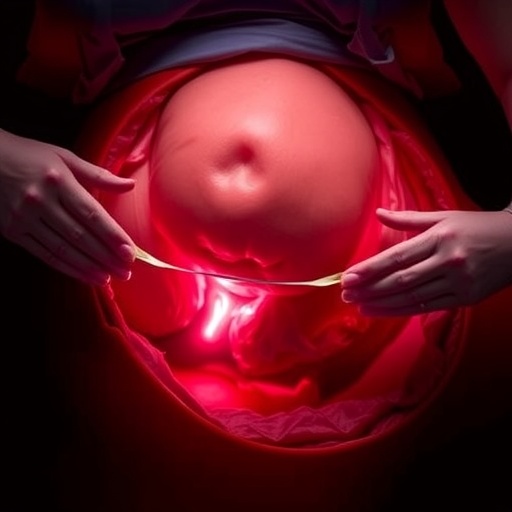In a striking development that sheds new light on the insidious dangers of environmental pollutants, a multidisciplinary team led by Norén, Blomberg, and Lindh has unveiled pivotal findings regarding the transplacental transfer efficiency of perfluoroalkyl substances (PFAS). This research, emerging from the highly scrutinized Ronneby Mother-Child Cohort, offers a window into how persistent chemical contaminants from prolonged exposure to heavily polluted drinking water permeate the most vulnerable—developing fetuses. The comprehensive study, published in the Journal of Exposure Science and Environmental Epidemiology, meticulously quantifies how these stubborn compounds traverse the placental barrier, raising profound implications for public health worldwide.
PFAS, a class of synthetic chemicals known for their strong carbon-fluorine bonds, have been ubiquitously applied since the mid-20th century in products ranging from non-stick cookware to firefighting foams. Their extraordinary resistance to degradation has earned them the moniker “forever chemicals,” prompting escalating concern about their persistence in human biological systems. The Ronneby cohort presents a unique natural experiment where years of contamination in local drinking water have led to some of the highest known PFAS body burdens in exposed populations. This backdrop allowed the research team to characterize the kinetics of maternal-fetal PFAS exchange with unprecedented precision.
Central to this work was the mechanistic elucidation of how PFAS molecules navigate the complex physiology of the placenta—a transient but critical organ that balances protection and nourishment of the fetus. Using advanced chromatographic and mass spectrometric techniques, the researchers measured PFAS concentrations in maternal serum samples alongside matched cord blood specimens collected at birth. Their results demonstrated distinctly variable transplacental transfer efficiencies depending on the chemical structure and carbon chain length of individual PFAS. Notably, shorter-chain compounds exhibited higher placental permeability, corroborating hypotheses about molecular size and protein-binding affinity influencing fetal exposure risk.
The implications of these findings are profound given mounting evidence linking prenatal PFAS exposure to altered immune function, impaired neurodevelopment, and metabolic disturbances in offspring. By delineating the exposure gradient from mother to fetus, the study provides critical data for environmental health risk assessments and regulatory policies aimed at protecting pregnant women and their developing children. Furthermore, the sustained exposure context of the Ronneby cohort highlights the cumulative burden of such pollutants—dynamics rarely captured in cross-sectional investigations.
Underpinning the analysis was a robust statistical framework adjusted for confounders such as maternal age, parity, and socioeconomic status, thereby strengthening causal interpretations. The application of longitudinal biomonitoring enabled discernment of temporal trends in PFAS levels throughout gestation, revealing not only initial transfer but potential accumulation trajectories in fetal compartments. This nuanced portrait of exposure dynamics suggests that prenatal PFAS burden cannot be fully understood through single time-point measurements alone, emphasizing the necessity of repeated sampling in epidemiological studies.
Equally groundbreaking was the integration of toxicokinetic modeling to simulate placental transport mechanisms. The researchers employed physiologically based pharmacokinetic approaches to reconcile measured concentrations with known biophysical properties of PFAS molecules. This fusion of empirical data with computational modeling enhances predictive capabilities for gestational exposure scenarios in diverse environmental contexts. Such tools are invaluable in extrapolating findings to populations with varying consumption patterns and contamination profiles.
From a molecular toxicology perspective, the study also prompts a reevaluation of PFAS interaction with placental transport proteins such as albumin and fatty acid binding proteins, which may mediate selective passage. The differential binding affinities and competitive interactions among PFAS congeners underscore the complexity of fetal exposure pathways. These biochemical nuances have far-reaching implications for understanding not only PFAS toxicodynamics but also potential interventions to mitigate prenatal uptake.
Moreover, the Ronneby study raises urgent questions about the adequacy of current regulatory thresholds for PFAS contamination in drinking water. Persistent high-level exposures documented in this community have been associated with measurable transplacental transfer, spotlighting potential gaps in environmental safety standards. The findings advocate for revisiting permissible exposure limits with particular emphasis on vulnerable subpopulations such as pregnant women and developing fetuses, who bear disproportionate risks.
The research also contributes to the broader narrative on the legacy of industrial pollution and the ethical imperative for remediation. Communities like Ronneby, exposed for prolonged periods to tainted water supplies, exemplify environmental injustice and the need for systemic policy reform. By concretely demonstrating how contamination seeps into the earliest stages of human life, this work fuels calls for more aggressive clean-up initiatives and proactive monitoring programs nationwide.
Intriguingly, the study hints at intergenerational consequences by revealing how prenatal PFAS exposure may set the stage for lifelong health challenges. The placenta’s partial permeability means that chemical insults encountered in utero could link to disease susceptibilities manifesting years later, from autoimmune disorders to endocrine disruption. Consequently, this research not only documents exposure but also charts a trajectory for future longitudinal studies probing long-term outcomes.
Public engagement with these findings is crucial, as awareness drives advocacy and behavioral change. The research team’s transparent communication of risks empowers expectant mothers to make informed decisions about water sources and consumption habits, while galvanizing community-level demand for infrastructure improvements. This dynamic underscores the vital role of science in translating complex molecular insights into tangible public health benefits.
Technological innovations also emerged from this study, including refinements in analytical detection limits that permitted quantification of PFAS at ultra-trace levels in biological matrices. These methodological advances pave the way for continued surveillance and early warning systems capable of identifying emerging contaminants. As the scientific community confronts an expanding array of novel PFAS variants, such capabilities will be indispensable.
In conclusion, the revelation of efficient transplacental transfer of PFAS after years of sustained environmental exposure signals a clarion call for intensified research, regulation, and remediation efforts. Norén, Blomberg, Lindh, and colleagues have charted a critical path forward by marrying rigorous analytical science with impactful epidemiology, spotlighting an invisible threat that crosses biological boundaries to imperil the next generation. Their work not only enriches our understanding of chemical toxicology but fuels urgent discourse on safeguarding maternal and child health in an increasingly contaminated world.
—
Subject of Research: Transplacental transfer efficiency of perfluoroalkyl substances (PFAS) following long-term exposure to contaminated drinking water
Article Title: Transplacental transfer efficiency of perfluoroalkyl substances (PFAS) after long-term exposure to highly contaminated drinking water: a study in the Ronneby Mother-Child Cohort
Article References:
Norén, E., Blomberg, A.J., Lindh, C. et al. Transplacental transfer efficiency of perfluoroalkyl substances (PFAS) after long-term exposure to highly contaminated drinking water: a study in the Ronneby Mother-Child Cohort.
J Expo Sci Environ Epidemiol 35, 445–453 (2025). https://doi.org/10.1038/s41370-025-00758-2
Image Credits: AI Generated
DOI: May 2025
Tags: epidemiological research on PFASforever chemicals and public healthhealth implications of PFAS exposureimpact of PFAS on fetal developmentlong-term exposure to environmental pollutantsmaternal health and environmental toxinsmaternal-fetal PFAS exchangepersistent chemical contaminants in drinking waterPFAS transplacental transfer efficiencyplacental barrier permeabilityRonneby Mother-Child Cohort studysynthetic chemicals and human biology





